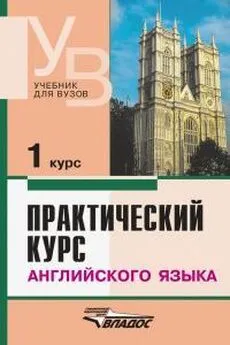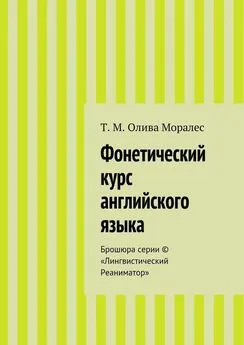Владимир Аракин - Практический курс английского языка 1 курс
- Название:Практический курс английского языка 1 курс
- Автор:
- Жанр:
- Издательство:ВЛАДОС
- Год:1998
- ISBN:нет данных
- Рейтинг:
- Избранное:Добавить в избранное
-
Отзывы:
-
Ваша оценка:
Владимир Аракин - Практический курс английского языка 1 курс краткое содержание
I - V курсов педагогических вузов.
Цель учебника – обучение устной речи на основе развития необходимых автоматизированных речевых навыков, развитие техники чтения, а также навыков письменной речи.
Практический курс английского языка 1 курс - читать онлайн бесплатно полную версию (весь текст целиком)
Интервал:
Закладка:
fork. 4. On the left of each person is a table-napkin and a plate with a roll on it.
5. Next to the piano is a tall bookcase standing against the window. 6. On the left
is a large window. 7. Under the window there's a radiator. 8. On the settee there
are two cushions. 9. On the ground floor there's the dining-room, the lounge or
sitting-room, the kitchen and the hall. 10. In the hall we see a stand for hats,
coats and umbrellas. 11. On this floor there are four bedrooms, a bathroom and a
lavatory. 12. On the top of the roof there are three chimneys. 13. In front of the
house we have a small garden. 14. At the back of the house there's a much larger
garden with a lawn and some fruit-trees. 15. At the side of the house is a garage
where 1 keep my car. 16. On the dressing table, in front of the looking-glass,
you'll see a hair-brush and a comb, a hand-mirror, a bottle of scent and a powder-
box. 17. In the wardrobe I keep my suits and other clothes, which I hang on coat
hangers. 18. On each side of the fireplace there's an armchair. 19. In the centre of
the mantelpiece there's a clock and above it an oval mirror. 20. On the right you
can see a standard lamp. 21. By the table there's a small chair. 22. On the
extreme right there's a radio-set. 23. After this there'll be fish, meat or poultry
with vegetables, then a sweet and perhaps cheese and biscuits to finish with. 24.
Once or twice a week we go to a theatre or to the pictures. 25. A few minutes
later we hear a ring at the door. 26. At night when I feel tired and sleepy I go up
to my bedroom and switch on the electric light. 27. After a few minutes I fall
asleep. 28. Punctually at seven thirty in the morning, the alarm-clock rings
and wakes me up.
7. Repeat the sentences yourself until they sound perfectly natural to you. Do not
let your Russian pronunciation habits interfere.
8. a) Read the sentences according to the given models. Observe the sequence of
tones: first Mid-Level + Low Fall, then Low Rise + Low Fall, b) Listen to a fellow-
student reading the sentences. Tell him what his errors in intonation are.
Model: On > Sunday | we shall be at xhome. Cn 7 Sunday I
we shall be at xhome.
1. On Tuesday we have six lessons. 2. On Friday they have grammar. 3. On
Saturday we go to the concert. 4. On Sunday we have dinner at home. 5. On the
1st of May we have a holiday. 6. On the 26th of October I leave for the Urals. 7.
On the 18th of November we have a test. 8. On the 9th of May we have no
classes. 9. At 4 o'clock he is at home. 10. At half past 7 I get up. 11. At 11 o'clock
I am in bed. 12. At a quarter to 8 I do my morning exercises. 13. In front of the
window there is a flowerbed. 14. On the ground floor there is a library. 15. On
the first floor there are bedrooms. 16. For the present he is not here. 17. In
January we have our exams. 18. At the club we usually meet our friends. 19. At
our faculty there is a good language laboratory. 20. In September we begin our
studies. 21. At our University there is a good drama circle.
9. Change the word order in the following sentences according to 'the model. Pay
attention to the intonation of the adverbials.
;M о d e 1: He is at the vhospital on Monday.
'■•
On 7Monday j he is at the xhospital.
1. We have our meals in the dining-room. 2. The Browns usually have a bowl
of fruit on the sideboard. 3. There's a carving-knife and fork in front of the host.
4. There is a tall bookcase next to the piano. 5. There is a large window on the
left. 6. There is a radiator under the window. 7. There are two cushions on the
settee. 8. We see a stand for hats, coats and umbrellas in the hall. 9. There are
three chimneys on the top of the roof. |0. There's an armchair on each side of the
fireplace. 11. You can lee a standard lamp on the right. 12. There's a small chair
by the table. 13. There's a radio-set on the extreme right. 14. We
go to the theatre or to the pictures once or twice a week. 15, We heard a ring
at the door a few minutes later. 16.1 fell asleep after a few minutes.
10.
Your teacher will suggest an adverbial phrase. You in turn give a complete
sentence beginning with the adverbial. Use the sequence of tones: Mid-Level + Low Fall,
then Low Rise + Low Fall. Keep the exercise moving on rapidly.
Reference material for the teacher:
On Monday .... On Tuesday .... On Saturday .... On Sunday .... In August.... In
September .... In November .... On the 9th of May ... . On the 1st of September ...
. In June ... . At four o'clock .... At half past seven .... At a quarter to 2 .... In the
morning .... In the afternoon ... .At night.... Yesterday .... For the present.... Once
or twice a week .... Punctually at seven .... A few minutes later .... On the ground
floor .... Upstairs .... Behind the house ... . On the sideboard ... . Next to the piano
... . Under the window .... On the settee .... In the hall ... . On the dressing table ...
. In the wardrobe ... . On the right ... . By the table .... Opposite the fireplace ....
As a rule .... As you come into the room.... After a few minutes .... At the club ....
At our faculty .... In front of the house .... In the dining-room .... In front of the
host.... On the left.... On this floor. .. On the top of the roof.... At the back of the
house .... In the chest of drawers .... In the centre of the mantelpiece....
11. Translate the following sentences:
1. Перед домом есть небольшой сад. 2. На первом этаже есть библиотека. 3. Справа
стоит большой диван. 4. В центре комнаты — стол. 5. Слева стоит пианино, два кресла
и торшер. 6. На стене две картины. 7 В классной комнате нет карты. 8. В воскресенье
мы встаем позже. 9. В четверг отец работает дома. 10. В субботу мы дома после двух.
11. В девять часов ребенок должен спать. 12. В семь часов мы ужинаем. 13. В
институте есть столовая. 14. В половине одиннадцатого я обычно ложусь спать. 15. В
половине восьмого я завтракаю. 16. Без четверти восемь я иду в институт. 17. Во
вторник у нас нет грамматики. 18. В январе у нас экзамены. 19. Перед окном клумба.
20. На втором этаже есть читальный зал. 21 В институте есть хорошая библиотека. 22.
В два часа они обычно обедают. 23. В зале много студентов. 24. В этой английской
книге много хороших иллюстраций. 25. На его столе много книг
26 На земле много снега. 27. На небе мало облаков. 28. На полях много
цветов
12.
Listen to the dialogue. Mark the stresses and tunes. Practise and memorize it:
E 1s a: Patrick, what do you all do every day?
P a t r i с k: Do you really want to know? Well, on Monday we begin our
work for the week. On Tuesday Mother usually cleans the kitchen. Then on
Wednesday we send our dirty clothes to the laundry; Mother doesn't wash them.
On Thursday my Father often brings his friends home to dinner. My club holds a
meeting once a week, usually on Friday. And on Saturday we all go to the
cinema.
13.
Make up a micro-dialogue of the same kind. Your fellow-student will suggest a
question. Respond using the proper sequence of tunes. Continue the talk.
14/** This exercise is meant to develop your ability to hear and reproduce
intonation, a) Listen to the text sentence by sentence. Mark the stresses and tunes.
Practise the text, b) Record your reading. Play the recording back immediately for your
teacher and fellow-students to detect the possible errors. Practise the text for test
reading.
The Browns' Dining-Room
In the dining-room we have our meals: breakfast in the morning, lunch in the
middle of the day, tea in the afternoon, and supper or dinner in the evening.
Here you see Mr. and Mrs. Thompson who've just arrived from abroad and
are having dinner with the Browns. The host, Mr. Brown, is sitting at the head of
the table, and the hostess, Mrs. Brown, is at the other end. Mr. and Mrs.
Thompson are sitting on either side, facing each other.
The dining-room table is covered with a white cloth. Mrs. Brown has laid the
table in the usual way, and has put the right number of knives, forks, spoons and
glasses for each person. There's also pepper and salt, oil and vinegar, and
mustard. On the left of each person is a table-napkin and a plate with a roll on it.
In front of the host there's a carving-knife and fork.
On the sideboard the Browns usually have a bowl of fruit: apples, pears,
plums, cherries, grapes, oranges or bananas, according to the season. The
mistress of the house has just served the soup. After this there'll be fish, meat or
poultry with
vegetables, then a sweet, and perhaps cheese and biscuits to finish with.
15. Mark the stresses and tunes. It is not expected that each member of the group
will mark the text in exactly the same way. Practise reading your corrected variant:
Читать дальшеИнтервал:
Закладка:





![Владимир Аракин - Практический курс английского языка 3 курс [calibre 2.43.0]](/books/1072035/vladimir-arakin-prakticheskij-kurs-anglijskogo-yazyk.webp)




